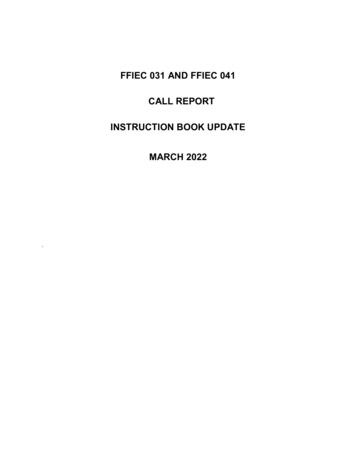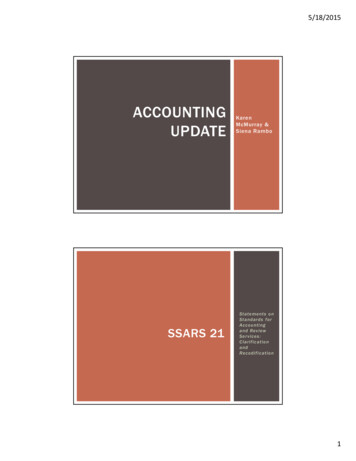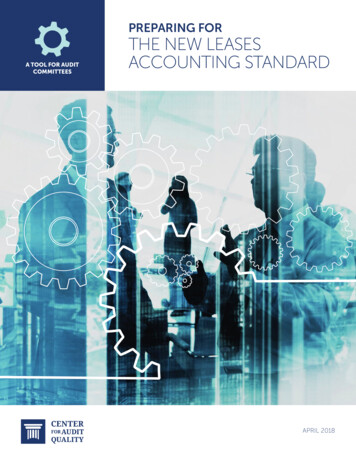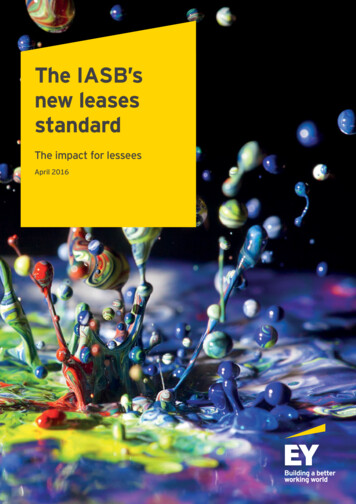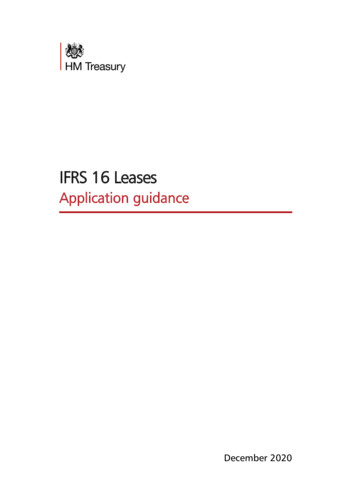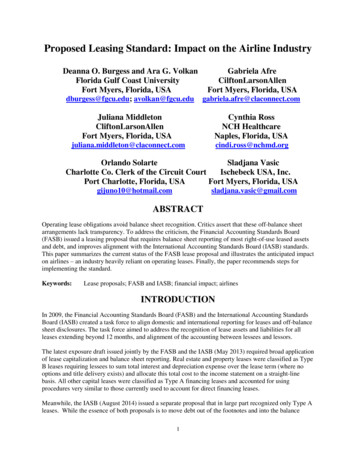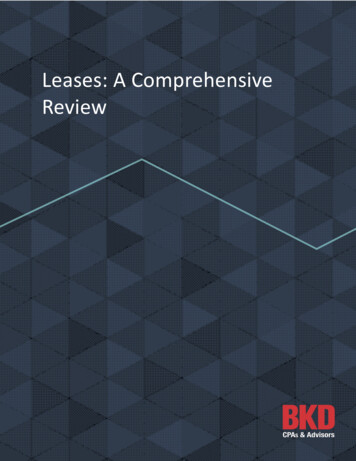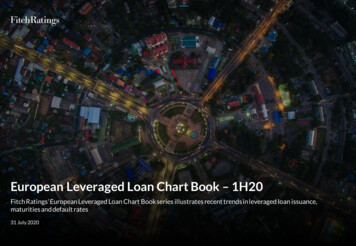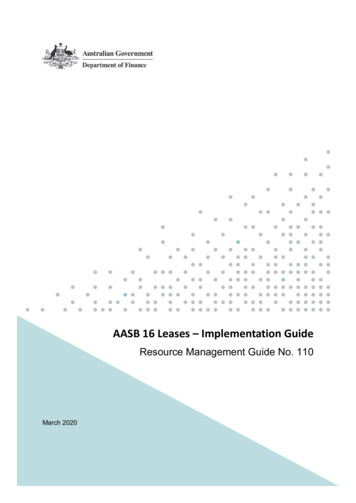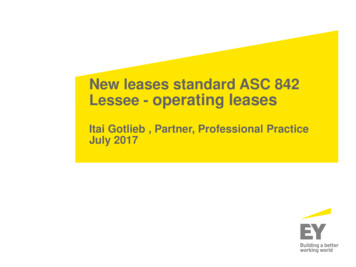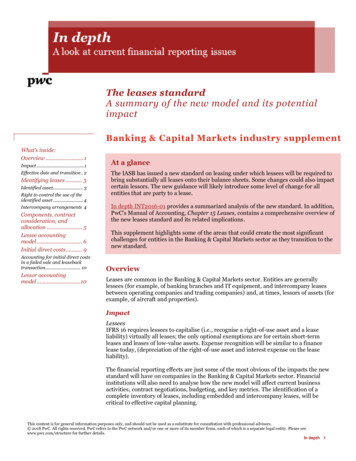
Transcription
University of MississippieGroveHaskins and Sells PublicationsDeloitte Collection1973Accounting for leveraged leasesClarence W. HoughtonFollow this and additional works at: https://egrove.olemiss.edu/dl hsPart of the Accounting Commons, and the Taxation CommonsRecommended CitationHaskins & Sells Selected Papers, 1973, p. 061-078This Article is brought to you for free and open access by the Deloitte Collection at eGrove. It has been accepted for inclusion in Haskins and SellsPublications by an authorized administrator of eGrove. For more information, please contact egrove@olemiss.edu.
ACCOUNTING FORL E V E R A G E D LEASESClarence W. HoughtonPartner, San Francisco OfficePresented before theBank Administration Institute,San Francisco-October 1973How can you borrow funds at 8 percent, lend them out at 4 ½ percent andstill get a 13 to 16 percent pretax yield on your investment? Sound improbable? To some, maybe, but more and more banks are doing it, and accountingfor the transaction is driving their auditors wild.It is called leveraged leasing. Although the practice was virtually unheardof ten years ago, today banks are investing in the neighborhood of 1.3 billion annually in leveraged leases. Substantially all of the jumbo jets flown byU.S. airlines are financed by leveraged leases; Anaconda's new 40 millionaluminum plant is financed by a leveraged lease; there is hardly a major railroad in the United States that is not operating railroad cars financed by leveraged leases.Central to all leveraged leases are the tax benefits associated with theownership of property, such as the investment tax credit and the right to useaccelerated depreciation. Leveraged leasing allows a company (such as an airline) that has more tax shelter than it can use to trade investment tax creditand accelerated depreciation to a company that needs tax shelter (such as abank) for a lower interest rate.STRUCTURE OF A L E V E R A G E D L E A S ETo understand just how this tradeoff is accomplished, let us look at a typical leveraged lease transaction.An airline wishes to acquire 1 million of new equipment which it intendsto use for fifteen years. Given the airline's credit rating and the value of thecollateral, an insurance company agrees to lend approximately 80 percent ofthe funds required at an 8 percent interest rate repayable in equal instalmentsover fifteen years. The remaining funds would be supplied by the airline withequity funds-the cost of which undoubtedly would exceed 8 percent. Thus,were the airline to purchase the equipment itself, its total average cost ofmoney would exceed 8 percent.
62Accounting Principles and ProblemsBy purchasing the equipment the airline would receive the right to use accelerated depreciation and investment tax credit. But, because of its manyother capital investments, the airline has more depreciation and investmentcredit than it can use. Hence, these tax benefits of property ownership are oflittle value to the airline.This is where the bank comes in. The bank has lots of taxable income. Itneeds tax shelter and is willing to pay for it. So the bank says to the airline,"Let us buy the equipment, and we will lease it to you over fifteen years at arental exactly equivalent to what you would have to pay the insurance company to liquidate their loan."For the airline this is obviously a great bargain. Because they no longersupply any equity funds, their effective interest cost drops to about 4.3 percent. The insurance company is willing to go along. It lends the long-termfunds to the bank instead of the airline. Further, it accepts a pledge of theairline's rental payments and the equipment as sole collateral for the loan—the same collateral it would have if it had made the loan directly to the airline. The bank supplies the equity funds and, as owner of the equipment, isentitled to receive the associated tax benefits plus any residual value of theequipment at lease termination.BENEFITS TO THE INVESTORWe have now structured a leveraged lease, the significant terms of whichare set forth in Exhibit 1. The question remaining is how good a deal this isfor the bank. The answer to this question lies in an analysis of the cash flows.These are set forth in Exhibit 2.Most of the cash flows shown in Exhibit 2 are self-explanatory. The leasereceipts are the airline's payment to the bank; depreciation is computed overeleven years as permitted under A D R ; loan interest is the 8 percent interestpaid to the insurance company; taxable income or loss is the lease receipt lessinterest and depreciation; tax payments at a 50 percent rate are one-half thetaxable income or loss; the loan principal payment is the portion of the insurance company loan payment that goes to amortize the loan; and the net cashflow is the sum of the cash flow amounts—the lease receipt, loan interest, taxpayments and principal payments.The net cash flow column is the item of particular interest to the bank.This is what the bank will receive for its 213,000 investment. A t first glanceit appears that the bank has not fared too well—it has invested 213,382, andit will receive a total cash return of only 131,691. On the surface the leaselooks like a losing proposition.
Accounting for Leveraged Leases63But bankers are far more sophisticated than that. They realize that rate ofreturn is a function not just of how many dollars but also of when they willbe received. Looking again at the net cash flow column, one can see thatthroughout the first eight years of the lease there are significant cash inflowsfrom tax savings. In fact, by the end of the eighth year these cash inflowsaggregate over 300,000. However, most of this cash must be used to paytaxes in the last seven years of the lease.Obviously the bank is not going to let this excess cash just sit in the vault;it is going to invest it. In fact, the bank really does not have to invest all ofthe excess cash inflows; it only needs to invest enough to meet future taxpayments. The rest it can keep as a recovery of its investment and maybeeven a little profit.The columns headed "Cash Available for Investment and Payment ofFuture Taxes" indicate how soon the bank has to start putting aside excesscash flows in order to liquidate the cash outflows during the last eight yearsof the lease. In this example it is assumed that invested funds will generate a 3percent aftertax rate of return.Cash flows that can be kept by the bank are shown as "Net Cash Flow toInvestor"-a total of 243,177. Subtracting the original investment of 213,382, we find that the bank will earn a 29,795 aftertax profit on theEXHIBIT 1Structure of Typical Leveraged LeaseEquipment cost: 1,000,000Lease term:15 yearsPayments:15 annual in arrears of 91,900Residual value: 50,000 to be received 6 months after leaseterminationFinancing: 213,382 equity and 786, 618 nonrecourse debtbearing interest at 8% and repayable in 15 equalannual instalments of 91,900 in arrearsDepreciation:Sum-of-the-years digits over 11 years as permittedunder A D RTax rate of lessor:50%Lessor's risk-freeinvestmentopportunity rate:3% after tax
91,90091,90091,90050,000 1,428,500 LeaseReceiptsEconomic AnalysisEXHIBIT 0,60645,45530,30315,152-0-0-0-01 1,000,000 Sum-ofDigitsDepreciation-TaxableIncome(Loss) 591,882 (163,382) 62,929 oanInterest (81,691) ,54625,000TaxPayments(Refunds) 131,691 786,618a Flow (42,546)25,000LoanPrincipalPayments64Accounting Principles and Problems
(23,697)(33,775)(36,477)(39,395)(42,546) (41,486) 32,070 345111,4882,35078,3561,23541,311 41,486 243,177 70,00068,84860,113 ment tax credit immediately available to reduce taxes.Proceeds from sale of equipment at lease g InterestBalanceEarneda 17 213,382 29,795Allocated toRecoveryofInvestment-0 2341,3091,3911,482NetCash FlowLease CashCash Flow EarnedFlow toEnding toIncome(from)Balance Investorat 6.29%Cash Available for Investmentand Payment of Future Taxes NetInvestmentBalanceAccounting for Leveraged Leases65
66Accounting Principles and Problemslease. The calculation in the last three columns of Exhibit 2 shows this to be a6.29 percent aftertax or a 12.58 percent pretax equivalent rate of return-nottoo bad when you consider it was accomplished by borrowing funds at 8 percent and lending them out at 4.3 percent.The last three columns of this exhibit are of particular interest to accountants-they show the pattern of earnings and the outstanding investmentthroughout the lease. It is particularly interesting to note that except for theresidual, the bank is cashed out of the lease before the end of the fourth yearinto the lease. Subsequent earnings represent only the accretion of the residual value. This phenomenon—long lease term with early lessor payout—ischaracteristic of substantially all leveraged leases. It is not only the source ofthe lessor's high rate of return; it is also- the source of the accountants'dilemma.But before attempting to account for this transaction, let us look again atvarious elements that contribute to the bank's 29,795 profit. These are summarized in Exhibit 3. As you can see, all of the bank's investment and profitis recovered from tax benefits and the residual value of the equipment. Therent collected from the airline is just sufficient to repay interest and principalon the insurance company loan.THE ACCOUNTANTS' DILEMMANow let us take a look at the dilemma facing the accountants in recordingthis leveraged lease transaction and in recognizing the income.Accounting Principles Board Opinion No. 7 sets forth two methods of accounting that may be used by lessors—the financing method and the operating method. As will be demonstrated, neither of these methods produces arational profit recognition pattern when applied to leveraged leases. Financing Method. The financing method accounts for a lease in much thesame manner as bankers account for discount loans. The excess of the aggregate rental receipts plus the residual over the equipment cost is recorded asunearned income and is amortized to income in decreasing amounts related tothe unrecovered investment. This method results in recording lease income inmuch the same pattern as interest income is recorded on a mortgage loan.Exhibit 4 shows a summary income statement by year using the financingmethod of accounting. Total earned income ( 428,500) represents the aggregate lease receivable plus the residual ( 1,428,500) less the equipment cost( 1,000,000). Earned income and the investment credit are amortized to income in relation to the declining lease receivable and residual investment. In-
Accounting for Leveraged Leases67terest expense is the amount paid the insurance company, and income (loss)before tax is the difference between total income and interest expense.Because investment credit income is not taxable, taxes on income are computed on the difference between earned income and interest expense (an 11,178 loss in year 1) times the assumed 50 percent tax rate.In this example, the lease itself results in a 11,691 loss. However, you willrecall that the excess cash inflows we set aside to pay future taxes were invested at a 3 percent aftertax rate. Those earnings ( 41,486) offset the 11,691 loss and generate our 29,795 net income.But accountants are not interested just in the magnitude of profits; theyare equally concerned with the timing of profit recognition. The basic accounting principle underlying the financing method of accounting is that income is reported on a declining basis in relation to the lessor's declining investment. This exhibit demonstrates that the recognition of net income hasEXHIBIT 3Summary of Receipts and DisbursementsReceipts:Rentals—15 X 91,900 1,378,50050,000ResidualTax benefits:Investment tax creditTax loss benefit. . . .Tax deferral benefit .70,00081,69141,486Total receipts . 1,621,677Disbursements:Loan principal 786,618591,882Loan interestTotal disbursements . 1,378,500Remainder . . .243,177213,382Less original investmentNet Profit 29,795
3,0152,4701,9281,382840294 70,000 ,11721,78718,45815,12911,7998,4705,1411,812 428,500aaInvestmentTax Credit 498,500 ,21925,34721,47317,59913,7279,8525,9812,106Total 591,882 ensecbBalance is amortized on sum-of-the-years digits over 15½years,Interest payments to long-term lender.Tax at 50% on earned income less interest nancing Method with Spreading of Tax CreditEXHIBIT 4 (81,691) 34)906cTaxes ,478)(2,540)(2,433)(2,141)(1,646)(938)71,200 (11,691) Net LeaseIncome ,3452,3501,236 41,486 dInvestmentIncome AfterTaxes 29,795 52,0901,6991,4121,2431,200NetIncomeRepresents the amount assumed to be earned at 3% after tax from the utilizationof surplus cash which results from deferral of tax payments. Such amountswould be recorded in the normal process of accounting for such investments.d (93,382) 27)2,106Income (Loss)Before Taxes
Accounting for Leveraged Leases69no relationship to the lessor's declining investment. Because the earnings fromtax deferral represent a major portion of total lease profits, the pattern of netincome tends to follow the flow of such earnings. Operating Method. If the financing method is inappropriate for leveragedlease accounting, the operating method is even worse. Exhibit 5 shows thepattern of profits that would be produced by the latter method.Under the operating method, rentals are reported as revenue and the costof the equipment is depreciated. In Exhibit 5 the equipment has been depreciated over the lease term on the straight-line method to its 50,000 residualvalue. Investment credit has been reported as revenue in the same pattern asthat of the rental receipts. The flow of income under the operating methodbears even less relationship to the outstanding lease investment than underthe financing method.NET INVESTMENT METHODUnfortunately, we have just run out of possible generally accepted accounting methods; there are only two—the financing method and the operating method. Neither produce results that even approach reasonablenesswhen viewed in terms of the economic realities of a leveraged lease transaction, and therein lies the accountants' dilemma.What is needed is an accounting method that reports the income on a pattern consistent with the economic analysis set forth in Exhibit 2. Manymethods have been suggested. I will discuss one of them here—a net investment method.Most accountants agree that accounting should reflect the underlyingeconomics of a transaction. Let us then start by examining just what elementsof our typical leveraged lease comprise the bank's profit.Exhibit 6 is a summary of the various elements of lease profits expressedboth in absolute dollars and in present-value dollars based upon the bank'srate of return inherent in the transaction (6.29 percent after tax).This analysis indicates that the lessor is investing in (1) a residual, (2) aninvestment tax credit, (3) a tax loss and (4) future tax deferral benefits. Thepresent value is a function of the timing of the related cash flows. Thus, theresidual has a relatively low present value because it will not be received untillease termination, some fifteen and a half years hence. On the other hand, theinvestment credit can be used to reduce the current tax bill and hence is notdiscounted. The timing of the tax benefits is somewhere in between and soshows a moderate discount.
EXHIBIT 91,90091,90091,90091,90091,90091,90091,90050,000 1,428,500 ab 70,000- 4,6674,6674,6674,6674,662cInvestmentTax 00 1,498,500 Totalcded 591,881- enseRentals as billed.Proceeds from sale of equipment at lease termination.Spreading of tax credit in proportion to depreciation.Interest payments to long-term lender.Straight-line depreciation to a 50,000 scrap ating Method with Spreading of Tax 00 1,591,881 0,000Total (93,381)- 422 (81,690)- 80fIncomeTaxes (11,691)- 1,236 41,486 ggNet Lease InvestmentIncomeIncomeAfter Taxes(Loss)Tax at 50% on rental income less depreciation and interest.Represents the amount assumed to be earned at 3% after tax fromthe utilization of surplus cash which results from deferral of taxpayments. Such amounts would be recorded in the normal processof accounting for such investments.f 1,000,000 eDepreciationIncome(Loss)BeforeTaxes 29,795- e
Accounting for Leveraged Leases71Converting the information in Exhibit 6 into an income stream for accounting purposes is probably much easier for a banker than an accountant.Bankers understand present values and compound interest far better than domost accountants. But i f you will forgive this accountant, he will try to translate bankers' knowledge into accounting entries.Exhibit 7 sets forth the lessor's investment in the leveraged tax lease and apattern of profits that conforms to the underlying economic analysis set forthin Exhibit 2. The bank's investment has been reduced by the 70,000 investment tax credit, which is received immediately. Further, the residual and itsrelated unearned income are shown on an aftertax basis for simplicity of explanation. (In actual practice, such amounts would be reported on a pretaxbasis.)Exhibit 7 demonstrates that each element of the bank's net investmentyields an aftertax rate of return of approximately 6.29 percent, and the in-EXHIBIT 6Composition of Bank's Net IncomeTotal DollarsRental receiptsPV at6.29%UnearnedIncome(dif) 1,378,500Less loan payments:Principal 786,618Interest591,882Net cash from leaseResidual (less 50% tax)Investment1,378,500-0-a25,000creditb 9,408 15,59270,00070,000148,177133,97414,203 243,177 213,382 29,795Future tax benefits:aTaxlossTax deferralTotala106,69141,486The residual is shown net of tax. The tax loss relating to the other elements of thelease is therefore 25,000 greater than shown in Exhibit 2.The investment tax credit is assumed to be immediately available as a reduction of taxpayments.b
87654321Yearb me 25,000aResidualValueNet Investment MethodEXHIBIT 62)41,486(962)41,48641,486 41,486cTax DeferralBenefits (i.e.Prepaid 0,113) 143,382(59,823)NetInvestment (14,203)8,433bUnearned TaxBenefit Income 106,691(68,848)Tax Loss Benefit(i.e. Deferred TaxAsset (Liability))Balance Sheet Accounts72Accounting Principles and Problems
0edcb(continued)Sale of residual at end of lease term.Earned income amortization at 6.29% of net investment.Prepaid interest amortization at 3% of deferred tax credit less prepaid interest.Current tax loss utilized or current taxes paid.Represents the amount assumed to be earned at 3% after tax from the utilization of surplus cash which results fromdeferral of tax payments. Such amounts would be recorded in the normal process of accounting for such investments.a161514131211109Accounting for Leveraged Leases73
ncomeE X H I B I T 7 continued4,7264,1543,3302,262 962cAmortization ofTax DeferralBenefits(i.e. 57 9,025Net LeaseIncome (Loss)Income Statement 4,7264,1543,3302,262962eInvestmentIncome afterTaxes9088558057557121,8135,257 9,025Income (Loss)Net74Accounting Principles and Problems
1,0901,1601,2351,3101,3921,483111213141516 41,4861,2362,3503,3454,2314,7985,0605,032 )(4,064) 41,4861,2362,3503,3454,2314,7985,0605,032 le of residual at end of lease term.Earned income amortization at 6.29% of net investment.Prepaid interest amortization at 3% of deferred tax credit less prepaid interest.Current tax loss utilized or current taxes paid.Represents the amount assumed to be earned at 3% after tax from the utilization of surplus cash which results fromdeferral of tax payments. Such amounts would be recorded in the normal process of accounting for such investments.a1,02710 29,7959689Accounting for Leveraged Leases75
Accounting Principles and Problems76come shown for each period is 6.29 percent of the net debit balance in thevarious elements comprising the net investment at the beginning of the year.Income for year 1, for example, is computed as shown in Exhibit 8.In addition to recording the income amortization entries, a tax loss of 137,695 was sustained during year 1 (see Exhibit 2). The resulting tax benefit ( 68,848) is credited to the loss tax benefit component of the leveragedlease investment.You will note that the net residual component of the lease investment(i.e., residual less earned residual income) continues to accrete at 6.29 percentthrough the sixteenth year, at which point it is sold. However, the net taxbenefits (i.e., deferred tax benefit and tax loss benefit, less the unearned income relating to the tax benefits) earn a 6.29 percent return only so long asthe bank has a net investment in this element of its investment (the tax benefit accounts have a net debit balance).By year 3, the bank has recovered all of its net investment in tax benefits.It then commences to receive the full benefit of the tax deferral (i.e., the nettax benefits have a credit balance). Normally such tax deferral would be conEXHIBIT 8Calculation of Earnings in Year 1Residual 25,000Unearned residual income(15,592)Present value—year 09,408Amortization rateEarned income6.29% 592Tax Benefits:Tax deferral benefit 41,486Tax loss benefit.106,691Unearned tax benefits(14,203)Present value—year 1133,974Amortization rate6.29%Earned incomeTotal earned income8,433 9,025
Accounting for Leveraged Leases77EXHIBIT 9Amortization of Tax Deferral Benefit in Year 4Deferred tax liability 73,566Less deferred tax benefit41,486Discounted value32,070Amortization rateInterest expense amortization3% 962sidered the equivalent of an interest-free loan. But the bank paid for these taxbenefits when it invested in the lease. The cost of its investment ( 41,486 inthe example) must be matched against the revenues that will now be produced by the surplus cash resulting from the deferral of tax payment. Theamount to be amortized each period is based on what the bank paid for thetax deferral benefit (3 percent after tax in the example). Thus, the deferredtax benefit (i.e. prepaid interest) is amortized against income based on the netoutstanding liability balance. The method used is identical to that which wouldbe applied to a discount loan and is demonstrated for year 4 in Exhibit 9.It is assumed that the bank will be able to otherwise invest the availablecash at an aftertax return of at least 3 percent. If such earnings were exactly 3percent they would total 41,486 over the lease term, equivalent to the totalamortization of the deferred interest expense. Although the bank could segregate the cash and separately invest the funds, thus isolating such income as aseparate element of the leveraged tax lease profit, in most instances the bankwould not do so. It would invest the surplus cash in the normal course of itsoperations and could earn more or less than the assumed 3 percent rate.Obviously, the total profitability of the lease could therefore be more or lessthan the amount shown in the example.Because tax deferral benefits do provide the margin of profits on leveragedtax leases, use of the net investment method imposes some constraint on themaximum tax deferral earnings that can be assumed. The greater the assumedearnings rate, the greater the margin of profit. Further, tax deferral earningsare recognized as an element of total lease profit on a different pattern (generally earlier) than actual investment earnings realization. Thus, under the netinvestment method the magnitude of assumed tax deferral earnings should belimited to what could be received on relatively risk-free investments such asU.S. Treasury bonds or high-grade municipal bonds.
78Accounting Principles and ProblemsECONOMIC REALITY V. GAAPThe net investment method of accounting appears to reflect the economicsof leveraged leasing. Why, then, you may ask, is it not adopted as an acceptedaccounting method along with the financing and operating methods? Theanswer to this lies in Opinion No. 11 of the Accounting Principles Board.APB No. 11 sets forth a long list of rules that must be followed in accounting for income taxes. Of particular importance in relation to the netinvestment method is the rule: "Thou shalt not present value-deferred incometaxes." The net investment method effectively presents value-deferred taxeswhen it assumes earnings from the tax deferral. Hence the dilemma.It is clear from the economic analysis that without the tax-deferral earnings, the bank would sustain a loss. Thus it is also clear that one of the majorassets the bank purchased was a deferral of taxes. Although a deferred taxbenefit can be associated with most purchases of depreciable assets, it isusually incidental to the primary purpose of the asset purchase. In the case ofthe leveraged tax lease, the deferred tax benefit is a principal source (and onan incremental basis the only source) of profits.Reconciling APB No. 11, which says, " Y o u cannot discount deferredtaxes," with the economics of leveraged leasing, where the rate of return iswholly dependent on tax deferral, was a topic of extensive discussion by theAccounting Principles Board before it was disbanded in favor of the newFinancial Accounting Standards Board in June of 1973. During its deliberations on the subject the APB reviewed more than twenty-five different proposed methods of accounting. None was adopted. Instead, the APB chose topass the subject of leveraged leases over to the new FASB. However, they didauthorize the issuance of an interpretation that requires disclosure of themethod used in accounting for leveraged leases.Many consider the issuance of this interpretation as tacit acceptance ofaccounting methods such as the net investment method. Some banks, in fact,are currently using such methods in accounting for their leveraged leases.Others feel that until the basic issue of discounting deferred taxes is resolved,methods such as the net investment method are unacceptable.This divergence of opinion is not too surprising, for it is indeed rare thatyou can get all accountants to agree on a single issue. However, there is onething that most accountants do agree on—leveraged leases are unique and require a unique accounting m
Structure of Typical Leveraged Lease Equipment cost: 1,000,000 Lease term: Payments: Residual value: Financing: Depreciation: Tax rat oef lessor: Lessor's risk-free investment opportunity rate: 15 years 15 annual in arrears of 91,900 50,000 to be received 6 months after lease termination 213,382 equity and 786, 618 nonrecourse debt
